- A DC machine can act as a DC generator as well as a DC motor.
- A DC machine is classified as a DC motor when it converts electrical energy into mechanical energy as its output.
- It is a machine that converts electrical energy into mechanical energy.
- Principle of a DC Motor: Placing a current-carrying conductor in a magnetic field results in it experiencing a force.
- A Direct Current motor is an electric motor that uses direct current (DC) to generate rotational motion. It is an electric motor that converts electrical energy into mechanical energy.
How Does a DC Motor Work?
A DC motor uses a magnetic field to interact with a current-carrying coil, causing the coil to rotate. The rotation is achieved by the interaction between the magnetic field and the current flowing through the coil.
Table of Contents
Key Components of a DC Motor
1. Stator: The stationary part of the motor that provides the magnetic field.
2. Rotor: The rotating part of the motor carries the current-carrying coil.
3. Commutator: A device that switches the current flow to the coil, allowing the motor to rotate.
4. Brushes: Devices that maintain contact between the commutator and the power source.
Types of DC Motors
1. Brushed DC Motor: Uses brushes to maintain contact between the commutator and power source.
2. Brushless DC Motor: Uses electronic controllers to switch the current flow, eliminating the need for brushes.
Derivation for Torque
The torque produced by the this motor is due to the interaction between field flux and an armature flux as shown in the figure.
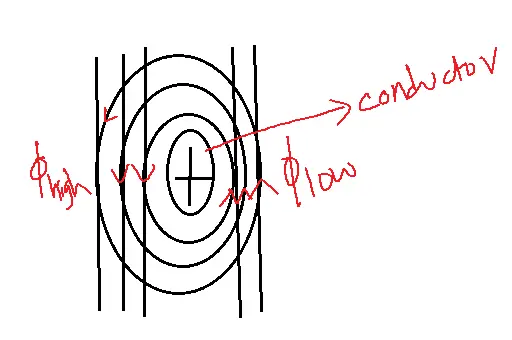
Torque is the product of force and arm distance.
T = F x r
Work done per revolution = F x distance(2πr)
Work done per n revolution = F x 2πrn J/sec
Work done per n revolution in minimum = F x 2πrn/60
P = T xW J/sec or watts
P = torque x angular velocity.
Back emf of DC motor or Condition for maximum Mechanical Power developed

VL=IaRa+Eb
VLIa= Ia2Ra+EbIa
VLIa-Pin
Ia2Ra—copper loss
EbIa—electrical equivalent for mechanical voltage
Pm=PmIa– Ia2Ra—dp/dIa = VL-2PmIa=0
Eb = VL/2
A DC motor achieves maximum power output when the back electromotive force (EMF) is comparable to half of the applied voltage.
Armature Torque
Pm=w X T(tow)
EbIa= w X T(tow)
Mechanical Power developed Angular velocity X Tow developed
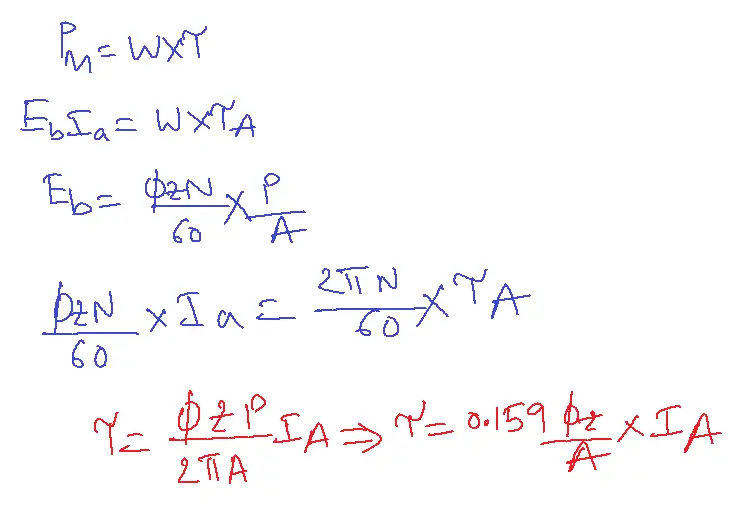
Separately Excited DC Motor

Self Excited DC Motor
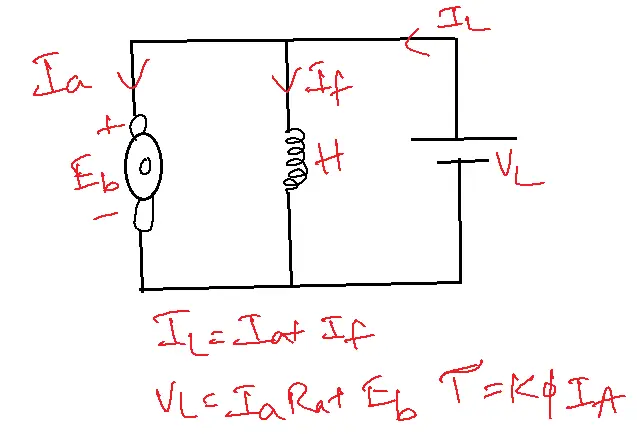
DC Series Motor
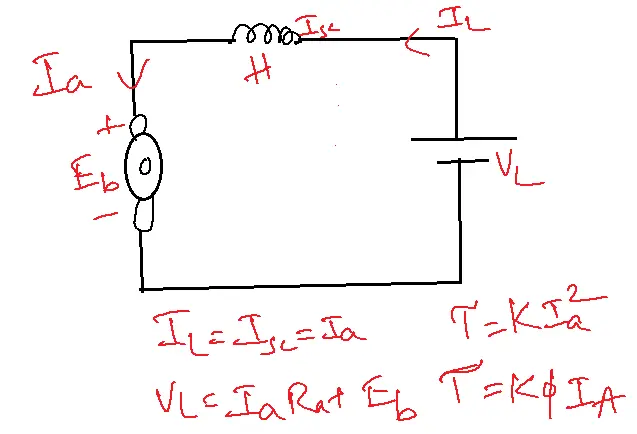
IL=ISC=Ia—1
VL=Ia(Ra+Rsc)+Eb—2
DC Compound Motor
Long Shunt DC Compound Motor
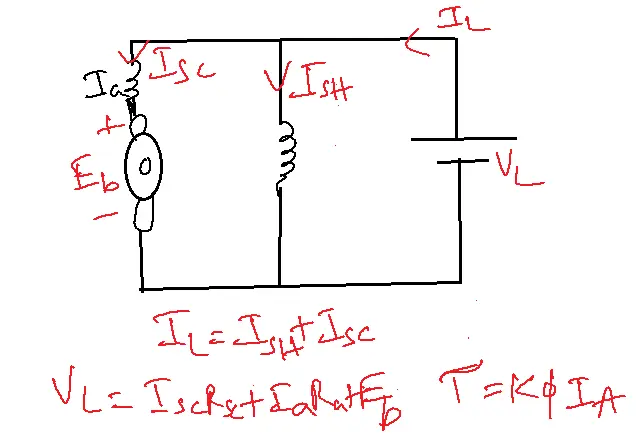
Short Shunt DC Compound Motor
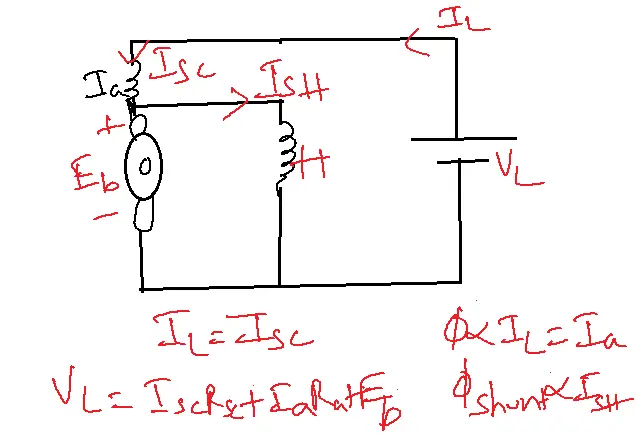
In the case of the shunt motor field flux is proportional to the shunt field current.
In the case of the series motor, field flux is proportional to the series field current or Armature current.
Characteristics of DC Motor
1. Torque versus Armature current
2. Speed versus Armature current
3. Speed versus Torque.
Advantages of DC Motor
1. High Torque: It offers high torque at low speeds, making it suitable for applications requiring high starting torque.
2. Low Speed: It can operate at low speeds, making it ideal for applications requiring precise control.
3. Easy Control: These motors are easy to control, with simple speed and direction adjustments.
4. High Efficiency: These motors have high efficiency, converting electrical energy into mechanical energy.
5. Compact Design: These motors possess a small design, making them suitable for applications with limited space.
6. Low Maintenance: These motors require low maintenance, with few moving parts and no brushes to replace.
7. Reliability: These motors are reliable, with a long lifespan and minimal risk of failure.
Disadvantages
1. Brush Wear: Brushed motors require regular brush replacement, increasing maintenance costs.
2. Heat Generation: These motors generate heat, potentially leading to overheating and reduced lifespan.
3. Limited Overload Capacity: These motors have limited overload capacity, making them unsuitable for applications with frequent overload.
4. Sensitive to Voltage: These motors are sensitive to voltage fluctuations, potentially leading to reduced performance.
5. Noise: These motors can produce noise, potentially causing disturbance in quiet environments.
6. Cost: These motors are expensive, especially high-power or high-precision models.
7. Limited Speed Range: These motors have a limited speed range, making them unsuitable for applications that require high-speed operation.
Applications
- DC Motor Equivalent Circuits: These motors can be represented using equivalent circuits of resistors, inductors, and voltage sources. Network analysis techniques are employed to study the motor’s behavior, such as calculating starting current, steady-state current, and speed-torque characteristics.
- Motor Control Systems: Network analysis helps engineers design and analyze motor control systems by evaluating stability, transient response, and control strategies.
- Power Loss Analysis: Network analysis helps identify power losses in this motor system. By examining voltage drops and current flow through various components in the equivalent circuit, engineers can pinpoint areas for efficiency improvement.
- Fault Diagnosis: Network analysis can diagnose faults in these motors by comparing measured and expected parameters, and detecting issues like open or short circuits.
- Efficiency Optimization: Through network analysis, engineers can optimize the efficiency of DC motor systems. By analyzing the power flow and losses in the network, they can identify opportunities to reduce energy consumption and enhance overall system performance.
FAQs
1. How is a DC motor represented in a network analysis?
- A DC motor is represented using an equivalent circuit composed of resistors, inductors, and voltage sources. This model simplifies the motor’s complex behavior for analysis using network techniques like Kirchhoff’s laws and circuit theorems.
2. What parameters are analyzed using network analysis for a DC motor?
- Network analysis helps determine:
- Starting current: The high current surge when the motor is first turned on.
- Steady-state current: The current flows when the motor reaches a constant speed.
- Speed-torque characteristics: The relationship between motor speed and the torque it produces.
- Power losses: Identification of energy losses due to resistance and other factors.
3. How does network analysis help in designing motor control systems?
- By modeling the motor and its control circuit as a network, engineers can:
- Evaluate system stability and ensure it doesn’t oscillate or exhibit undesirable behavior.
- Analyze transient response to understand how the motor reacts to changes in input or load.
- Assess the impact of different control strategies on motor performance.
4. Can network analysis be used for fault diagnosis in DC motors?
- Network analysis is instrumental in identifying faults by comparing actual measurements with the predicted values derived from the network model. Deviations may indicate:
- Open circuits in windings or connections
- Short circuits within the motor
- Faulty brushes or commutator segments
5. How can network analysis improve DC motor efficiency?
- Network analysis allows engineers to:
- Analyze power flow and identify areas of high loss.
- Optimize component values and control strategies to minimize losses.
- Evaluate the impact of design changes on overall efficiency.
